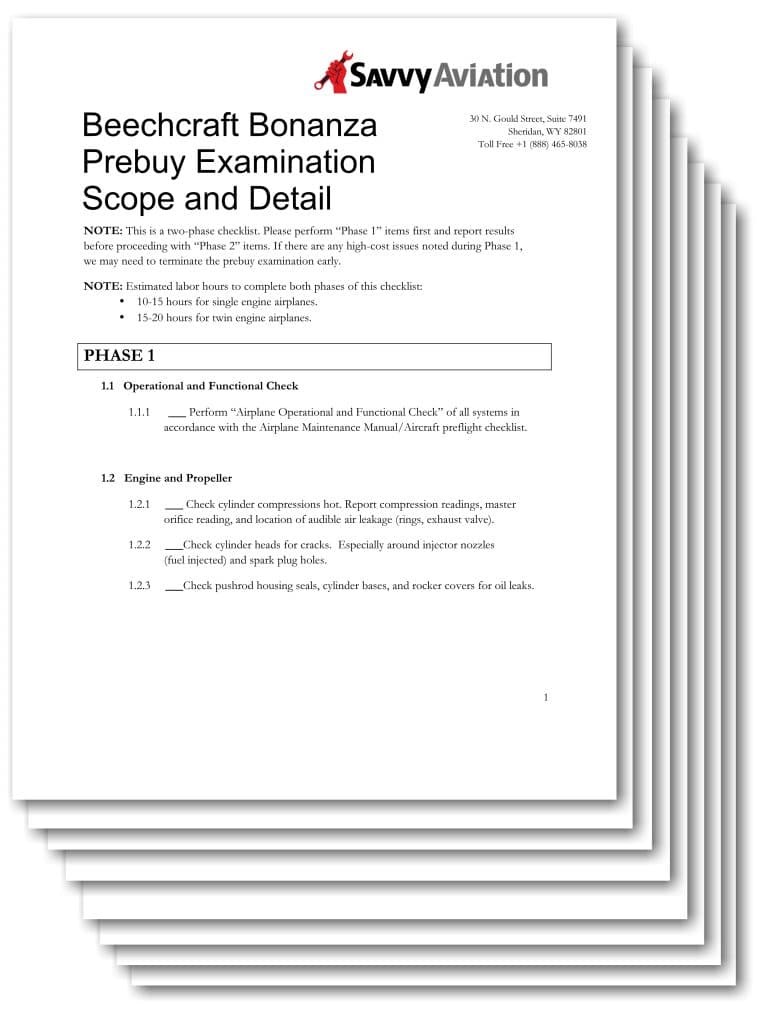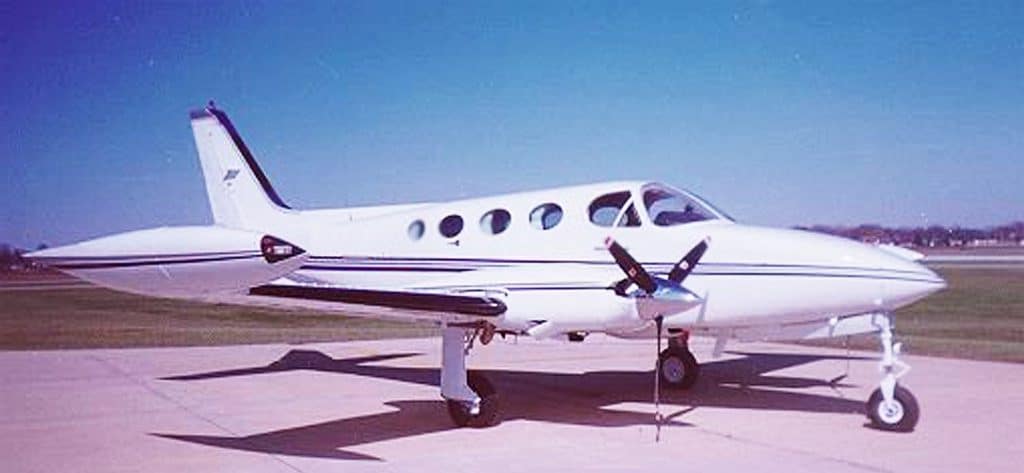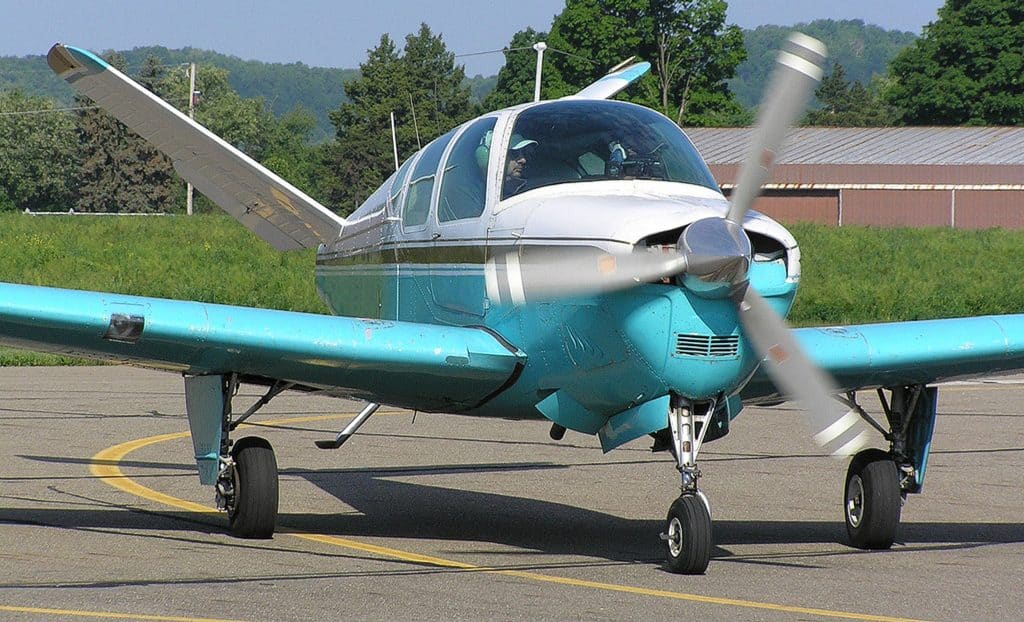
My company manages a lot of prebuys. At any given point in time, we typically have a dozen of them in progress. We’ve managed thousands of them over the years, and seen the good, the bad, and the ugly.
Most of the time, the aircraft turn out to be in decent shape and the outcome is a successful purchase by our client, often after some last-minute price negotiations based on prebuy findings of airworthiness discrepancies that we think the seller should pay to correct. Once in a while, however, the prebuy uncovers problems serious enough that we advise our client to walk away and find another purchase candidate.
We always try to arrange for the prebuy examination to be done by a shop or mechanic highly experienced with the particular make and model involved, and who is truly independent. By independent I mean that the selected shop or mechanic has no prior exposure to the aircraft being examined, and no prior relationship with the seller or (if applicable) the seller’s broker. This is the only way we can have confidence that the prebuy findings will be thorough, honest and unbiased.
Let me tell you about two of these prebuys. One was truly independent, the other—well—not so much. I’ve changed some names to protect the guilty, but the rest is exactly what happened.
Cabin-Class Twin
Burt was looking to buy a cabin-class pressurized twin. After diligently searching the usual sites—Controller, Trade-a-Plane and Aircraft Shopper Online—he located what looked like a promising purchase candidate. It was a Cessna 340 that was listed by an airplane broker named Brad on behalf of Sam, its owner. Burt made an offer, Brad conveyed it to Sam, and Sam accepted it. Since Burt lived on the West Coast and Sam’s airplane was based in the Deep South, Burt asked my company to manage a prebuy for him.

We’re always a bit nervous about managing prebuys on airplanes as sophisticated and complex as a Cessna 340 because we’ve seen so many of them become deep money pits unless very well-maintained and cared for. There are only a handful of twin Cessna specialty shops in the U.S. that we’d feel comfortable evaluating an airplane like this. The closest ones were located in Texas, so we advised Burt that we recommended having the prebuy examination done at a shop in Dallas.
We’d worked with this shop on a number of prior occasions, and knew them to be extremely knowledgeable about twin Cessnas and also extremely thorough. Actually, this shop was so picky that we hesitated to use it for annual inspections for fear our clients would have to take out a second mortgage. But a picky shop like this is precisely the kind you want for a prebuy.
We contacted the Dallas shop about doing Burt’s prebuy. They said their shop schedule was booked solid and it would be some weeks before they could look at Sam’s airplane.
Sam balked at this. He wasn’t happy about flying his airplane as far as Dallas for the prebuy, and wasn’t willing to wait weeks to have the prebuy done. Brad (Sam’s broker) became concerned that the deal was falling apart, and suggested that the prebuy be done by an A&P/IA named Ed who was located close by and whom Brad knew to be knowledgeable about twin Cessnas.
Ed? Really?
We’d never heard of this Ed fellow before and knew nothing about his qualifications. All we really knew was that Brad recommended him, which set off alarm bells because it would be a clear violation of our “independent prebuy” criteria, since clearly Ed had a prior relationship with the seller’s broker. We considered that a definite no-no. If Ed did the prebuy, we could never be sure whether his allegiance was to our client Burt (who wanted to ensure that the plane was airworthy and well-maintained) or to the broker Brad (who recommended Ed and who wanted the deal to close ASAP).
Meantime, Brad was telling Burt that he’d better get this deal done quickly because he had a couple of other interested buyers for Sam’s plane. (Brokers always say that, and buyers often believe them. Sigh.) So, contrary to our advice and much to our chagrin, Burt agreed to have Ed perform the prebuy examination of Sam’s plane. We reluctantly sent Ed a checklist of specific items we wanted him to look at during the prebuy, and we crossed our fingers. This was not starting out on the right foot.
No sooner had Sam’s plane been delivered to Ed’s shop for the prebuy, Brad (Sam’s broker) threw us another curveball. Realizing that the Cessna 340’s annual inspection was about to expire, Brad proposed to have Ed perform an annual inspection in lieu of the prebuy. Sam agreed to pay for the annual and for repair of any airworthiness discrepancies found during the annual. Burt thought this was a great idea, and immediately agreed.
We thought it was a terrible idea. Now Sam would be paying Ed’s bill, Ed would be working for Sam, Sam would be calling the shots, and Ed would have no duty of care to Burt whatsoever. From where we sat, this was no longer a prebuy whose purpose was to protect Burt from buying a lemon. Instead, it had morphed into a scheme cooked up by Brad and Sam to get the airplane sold with no questions asked. Sadly, Burt was fully on board with this, and we could not convince him otherwise.
Ed performed the annual inspection, performed a few thousand dollars worth of repairs, and signed off the airplane as airworthy. Burt bought the plane, had it flown to the West Coast, and started enjoying his new acquisition.
Pencil-Whipped?
Eventually, the airplane’s next annual inspection came due—the first on Burt’s watch. He had it performed by an outstanding shop in Northern California, one that we frequently work with and recommend. The inspection findings were catastrophic.
The shop quickly determined that all 12 cylinders on the two Continental TSIO-520-NB engines were illegal. They were all ECi cylinders whose removal from service had been mandated by AD 2016–16–12. The shop removed the cylinders and discovered that both camshafts were unairworthy. Burtt was now facing two unplanned engine major overhauls.
The shop also discovered major issues with the landing gear that would be very costly to correct. Our original prebuy checklist had requested that Ed give special attention to the landing gear (a known twin Cessna problem area) but obviously that didn’t happen. By the time the dust settled, the shop’s estimate to make Burt’s plane airworthy came to well over $300,000.
There is no doubt in my mind that had the prebuy been performed by the picky Dallas shop we originally recommended, the illegal cylinders and landing gear issues would have been uncovered at prebuy and Burt would never have purchased this airplane. Sadly, Burt decided to follow Brad’s advice instead of ours. I hate when that happens.
66-Year-Old Bonanza

Contrast this to Smitty’s experience. He found a 1958 Beech J35 Bonanza in Arkansas for sale by owner. Smitty and the seller agreed on a price, and we were asked to manage the prebuy. Once again, we were rather nervous about this one—not because the airplane was complex but because it was 66 years old. (In our experience, the older the airplane, the greater the likelihood of finding skeletons in the closet at prebuy.)
In most cases, we try to find an appropriately qualified shop or mechanic who can do an independent prebuy within a reasonable distance of where the aircraft is located—generally no more than one hour’s flying time away, preferably closer. In this case, however, we engaged Mike Teager A&P/IA (his real name), owner of Mobile Aircraft Maintenance, to come to Arkansas to do the prebuy. Mike operated a shop in Florida for more than 20 years, but these days he mostly travels around the country doing prebuys.
The Bonanza was kept in a T-hangar equipped with a well-stocked toolbox, air compressor, and jacks. Smitty arranged to meet Mike there so he could watch. Mike pulled the top spark plugs, performed a quick compression test (all cylinders 70/80 or better), and started borescoping the Continental IO-470-C engine. All the cylinders, pistons and valves looked good. Mike inserted the ‘scope through the oil filler port and was able to get some great images of several cam lobes and lifters, all of which looked good, too. He captured images of the inside of the wings and empennage, all remarkably corrosion-free. The prebuy seemed to be getting off on the right foot.
Diving Deeper
As he worked his way through the prebuy checklist we’d provided him, however, Mike started finding things that troubled him. He took copious notes of his findings and tons of high-resolution photos that he placed in a shared Dropbox folder so we could look at them. By the time he was done, he’d assembled a list of 44 airworthiness discrepancies. Here’s a sample:
“Window sealant failing in several locations. Windows starting to craze.
“Registration is still in previous owners’ names.
“Cowl flap cable extremely hard to operate, coming loose at instrument panel.
“Engine cowling in very poor condition, holes, cracks, improper repairs with less than minimum allowable rivet spacing.
“Ignition leads improperly routed, hard rubbinb on fuel injection lines.
“Many inspection panels have missing or damaged nutplates, incorrect screws installed.
“Both brake calipers are leaking badly, brake linings worn out, brake discs scored.”
“Alternator B+ cable chafed through insulation due to poor routing, fire hazard!!!
“Alternator field leads appear to be automotive wire and crimp terminals, very poor workmanship!
“All three landing gear struts exhibiting excessive hydraulic fluid leakage, need to be disassembled and resealed.
“Left aileron cables rubbing landing gear.
“Fuel stains in left wheel well.
“Nose gear cable assembled incorrectly, rubbing hard on the side of the pulley! Geometry is incorrect. Pulley needs to be removed and inspected. Cotter pins wrong size, appear to be automotive. Very poor workmanship.
“Smoking loose rivets in several locations on wings and fuselage.
“Engine cooling baffles fit poorly, cracked in several places, missing screws and rivets, very poor workmanship!
“Wiring behind instrument panel is a mess, improperly secured, missing hardware, melted spiral wrap, rubbing in many places, very poor workmanship!
“Alternate air door not sealing properly, sticks open, improper repairs with pop rivets, safety wired backwards. Needs to be replaced due to illegal repairs.
“Induction boot is disintegrating, pieces being sucked into the engine.
“Corrosion on and around battery box.
“Rivets incorrectly installed in lower engine compartment.
“Induction balance tube bracket broken, laying in the cowling. Clamp rubbing holes in sheet metal and worn spots in balance tube. Needs to be removed to be properly inspected!
“Exhaust missing hardware, incorrect nuts and bolts installed, corrosion on hardware.
“Crack in tunnel of engine compartment.
“Fuel transducer flopping around, not secured to anything.
“Incorrect routing of mixture cable!
“Vacuum pump has carbon buildup under it and small metal shavings, likely to fail soon.
“Oil dripping from tach drive.
“Crack in lefthand aileron skin! NO CRACKS ALLOWED in primary flight control surfaces!
“Borescope inspection indicates that two cylinders are not broken in correctly.
The Verdict
Mike summed up his thoughts on this airplane this way: “Aircraft is not airworthy at the time of the inspection. Please review Dropbox folder for current condition photos. The aircraft has been recently poorly maintained and likely the work was performed by a non-A&P with little to no supervision. I would NOT feel safe test flying this Bonanza!”
We reviewed Mike’s images and were suitably horrified. “Smitty, I think it goes without saying that we absolutely do NOT recommend buying this aircraft.”
“This plane is certainly not what the seller represented,” Smitty said. “This Bo was still basically corrosion-free after 66 years. Too bad the maintenance work was so atrocious. With a little love along the way, it could have been a great plane. What a shame. I guess I’ll start looking for another candidate.”
It’s certainly sad when a prebuy ends in a thumbs-down verdict like Smitty’s did. But it’s a lot sadder when the thumbs-down verdict comes at the first annual inspection on a new owner’s watch the way Burt’s did. The difference is that Smitty had a thorough, honest, independent prebuy and Burt didn’t.